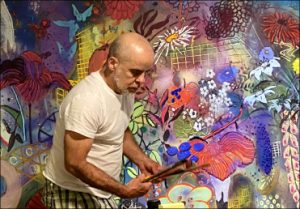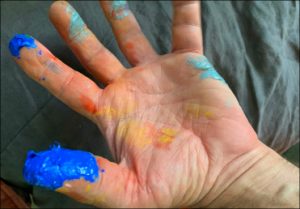ABOUT Gilvan Nunes
Gilvan Nunes started to paint in the 1980s at the prestigious School of Visual Arts at Parque Lage in Rio de Janeiro; epicenter of the resurrection of painting in Brazil. Since then, his work has evolved into a robust and colorful explosion of a fantastic nature. Like other artists who flourished at this time, Nunes continues to investigate alternatives to painting in his own time, free of collective principles; as the artist that found his own pictorial system. Gilvan’s art is a vigorous painting that erupts without a project, whose results of the procedure suggest floral motifs and landscapes. The beauty of these paintings despite their trivial reasons does not contradict the complexity of the true pictorial action of his work. The manual process is, therefore, for the artist today, the way he expresses his visual thought and lets his poetic sense flow, resulting in his poetic works of art.
HYLOMORPHISMS
The exhibition Hylomorphisms, by Gilvan Nunes at Galeria Patricia Costa, in Rio de Janeiro, brings together paintings, drawings, ceramics and porcelain produced by the artist in the United States, where he has been living for about five years.
A considerable part of his paintings and drawings can be associated with abstractionism, since they are essentially composed of stains and graphics with a strong material evocation, a condition that the artist never failed to emphasize in his works. This is one aspect of this production, which can also be perceived in its opposite form: compositions of ambiguous configuration that evoke still lifes and landscapes, vases and wall pieces with decorative and floral ornaments, as well as diffuse portraits modeled in small dimensions, works that problematize the existence of fixed identities and categories because of their provocative ambivalence.
The title given by Nunes to the exhibition, Hylomorphisms, helps to clarify the meanings of this exhibition and associates the artist’s work process with the thinking of Plato (c. 428 – 348 BC) and Aristotle (384 – 322 BC). These references show the verb-thematic content of his poetic invention, since hylomorphism, the mentioned philosophical concept, understood that all corporeal beings were composed of matter (hylé) and form (morphé). The distinction between matter and form is observable in the poetic dynamics of Gilvan Nunes’ work, as they are the elements that exercise, feed and produce the creative invention of artists and craftsmen.
Gilvan Nunes’ recent creative practice brings us ideas contiguous to the exhibition’s title, such as the productive function of the demiurge, a creative soul, an artificer of the world, who worked with matter or chaos to give them shape. In the Greek thought, particularly Plato’s, the demiurge would be a god or an organizing principle of the universe that does not create forms (morphé), only models them, based on the contemplation of ideas.
According to Giulio Carlo Argan and Maurizio Fagiolo (Art History Guide, Editorial Estampa, 1977), “The concept of art therefore does not define categories of things, but a type of value. This is always linked to human work and its techniques and indicates the result of a relationship between mental activity and operational activity.”
Gilvan Nunes’ work process seeks a spontaneous organization of the relationships between matter and form. The creative breath that lends meaning to his work resides in the instigating encounter of ideation and execution. According to Argan and Fagiolo, “the artistic value of an object is that which is evident in its visible configuration or, as it is commonly said, in its form”.
July 14, 2022
SUBurban landscapes
In the late ‘80s Gilvan Nunes began his artistic training at the Escola de Artes Visuais (EAV) at Parque Lage in Rio de Janeiro.
EAV had become a national reference for the reaction to conceptual art, whose emphasis on the idea, to the detriment of manual work, was internationally considered the biggest obstacle to the resumption of painting as the hegemonic artistic medium.
Marked by such a context, Nunes’ painting, however, was not restricted to the consecrated vogue, both discursive and practical, of the making and of the pleasure provided by this ancient medium or craft of human expression. For years, his work’s constant transformations resulted from the restless experimental impetus that led him to expand his painting beyond the field of conventionally established pictorial limits.
Although Gilvan’s production has painting as its permanent thread, his trajectory has been procedurally trodden over the tenuous boundaries that historically specified the various crafts (painting, sculpture, tapestry, ceramics) whose limits persist on the basis of an unknown terminological equivalence: the one that replaces the division of the arts by techniques, by their division into languages.
Until arriving at his current painting of rural and urban landscapes, the artist’s work underwent many transformations, some of them essential to his experimentation.
In this sense, we highlight the works from the period in which Nunes appropriated academic canvases, of unknown authorship, purchased at thrift stores, on which he painted white floral patterns, originally intended for wall decoration, with ink rollers. Also worthy of note are the collage with compositions of free hand and ink rollers, with some that were printed as serigraphs.
Only after almost three decades of work, Nunes moved away from the experiment aimed at expanding the pictorial field, redirecting it to landscape, a pictorial genre consecrated since the Renaissance.
When he started to produce entirely handcrafted paintings (ink on canvas), Gilvan did not abandon the productive and experimental restlessness that permeated his entire work. His recent works, as we have seen, can be defined, at first glance, from a thematic point of view, which is subdivided into two sub-themes: one with nature and rural scenes and the other with urban scenes.
However, when we observe the creation of these two types of landscape by the artist, we will see that they do not differ only in terms of sub-themes (urban landscape and rural landscape), but, above all, by the specific pictorial treatment given to each of them. While his rural scenes are clearly Expressionist, referring us to the pictorial possibilities established in the past, Gilvan’s urban landscapes are completely opposite in nature. Painted without any impasto, based on the application of grids that modulate both the painting and the cities that result from it, they emphasize that for the artist, the visual expression of his thought is inseparable from the poetic sense that qualifies his work.
Rio de Janeiro, 2017
Recent Works 2010
Gilvan Nunes started to paint back in the 1980s at the Parque Lage’s School of Visual Arts in Rio de Janeiro which, at that time, became the epicenter of the new wave of painting in Brazil. The strategic renewal of this conventional means of the artistic manifestation that seemed to be in the imminence of its announced death – caused by the dematerialization promoted in the previous decade by conceptual art and its unfolding – mobilized a vast contingent of young artists internationally. Like other artists that flourished during this period, Gilvan continues to investigate alternatives means for his paintings. The sum of these unique experiences contributes decisively to the expansion of the pictorial field, expands beyond the conventional technical-poetical limits and contradicts its historical stated term (definition).
The work of Nunes results frequently from the combination of two historically opposite genealogies: that of handcrafting, from the long tradition in arts, that depends mainly on the artist’s technical skills, and that of the the project, where the anticipation of the work comes from the idea, which legitimates itself in the ready-made object appropriation (Duchamp) and in the hiring of others for producing, as it occurs it in architecture and design.
If in one hand, handcrafting is for this artist an inseparable expression of its artistic thoughts and poetical elaboration Gilvan seems to think with his hands – on the other, it establishes limits to its handcrafting in some of its impersonal procedures such as the appropriation of objects, the prints, the collage and the assemblage.
The hybrid procedures that turn Gilvan’s work unique can be observed in the serigraphic prints.
They are landscapes composed from elements of industrial origin – its matrixes had been produced by the collage and overlapping of arabesques, circles, floral patterns, decorative infantile adhesives and vinyl stickers for cars over which he stamps flower patterns with rolls used to paint walls, previously used on paintings he purchased from anonymous artists in vintage shops.
The paintings shown here however go beyond the logic explained above. They are imaginary landscapes where floral and vegetation motifs that permit the procedural, expressive and
material organization of the canvases’ surfaces where the handcrafting rules absolute. To the exception of some canvases of small format of the series named Nocturnes, (in which the artist glues porcelain figures, appropriated from decorative-popular industrial circuit), its current paintings result exclusively from handcrafting.
In these twists and displacements reside the force and the poetical interest of the works by Gilvan Nunes. They are the visual witnesses of the hybridization, the edition of fragments from distinct, and even contradictory, practices that characterizes life as well as contemporary art.
Rio de Janeiro, 2010
ABOUT THE BIG SLUM (FAVELÃO)
Concieved in 2006 the Big Slum by Gilvan Nunes was not shown before. Neither has it been concluded. It consisted of a large scale painting, composed of dozens of canvases of different sizes, each one painted on a different color (red, pink, orange, black, white, brown, blue and green) and stamped with wall painting rolls’ that superimpose on the monochromatic surfaces floral patterns. In some of them the shadows of a helicopter, a machine gun and of a painter in front of his easel, are also painted.
At the end with a similar logic that emerges from improvisation and by the settling that predominates in the occupation of a Brazilian or Carioca social space (not always public), whose main representation is the slum or shanty town, Gilvan projected this work to the assembled, in a dense and chromatic explosive agglomeration.
In the last two years, comprehended between the conception of Big Slum and its first show, only now opened to the public, some recurrent traces in Gilvan Nunes’ production have been consolidated as poetic elements valued for the collection of his work. His paintings promote the fusion of two historically opposed genealogies. If on one hand, these are intentionally produced from impersonal procedures, their results, on the other hand, suggest something opposite: the personal and expressive execution.
When he’s appropriating paintings of anonymous artists or when he’s ordering them to be made by professional artists based on models chosen in books, magazines and photographs, Gilvan reduces the sphere of manual making, so dear to peers of his generation, to the use of mechanical processes (as to stamp*, for example). It is a minimal painting in the process, but extreme in the results, since the appropriated repertoires belong to the common knowledge and the Brazilian popular taste.
Favelão/Big Slum is presented to the public thanks to Project Illuminating the New, of Furnas, that chose Gilvan Nunes as the special guest of 2008. Between the initial idea of 2004 and its final configuration, now shown for the first time, the Favelão/Big Slum has improved. It grew to incorporate paintings of other phases of the artist. It consists not only of a more specific work in relationship to the others previously produced, but an alternative modality when compared to the more conventional ones, that expands the possible interpretations of his artistic production.
Rio de Janeiro, 2008
*Procedure also used by the artist in his previous work of the series caixa rendada/lace box in which he painted over academic and anonymous painting he bought at antique shops and laced them.
FERNANDO COCCHIARALE
– Art critic and curator, former Director of the Museum of Modern Art (MAM) of Rio de Janeiro, RJ, Brazil

